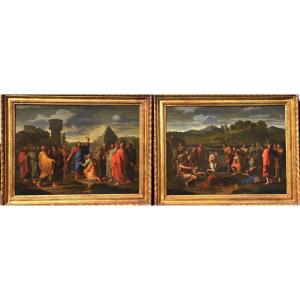This painting of extraordinary quality, rich in charm and tender humanity, depicts a festive dance of cupids, while angels play various instruments, probably in honor of the birth of Christ depicted on the right in the arms of the Madonna.
The spectacular sense of realism that emerges from the painting comes from the meticulous representation of shapes, decorations and details. In our panel in fact, the characters depicted shows delicate incarnations, modeled and finely detailed, this is to witness how the artist had to be a valid illuminator, because every element of the painting is cared for and there is no surface of the painting that is not detailed with a particular.
For this reason, Flemish paintings reveal a particular competitive called "Horror vacui", a term translatable as fear of emptiness and this consists in not leaving empty spaces inside the image.
The image of the artist is addressed to every form even marginal of the work, as the landscape and the shepherd with the donkey in the background. Dutch Golden Age painting is the painting of the Dutch Golden Age, a period in Dutch history roughly spanning the 17th century, during and after the later part of the Eighty Years' War (1568–1648) for Dutch independence.
The new Dutch Republic was the most prosperous nation in Europe and led European trade, science, and art.
The northern Netherlandish provinces that made up the new state had traditionally been less important artistic centres than cities in Flanders in the south.
The upheavals and large-scale transfers of population of the war, and the sharp break with the old monarchist and Catholic cultural traditions, meant that Dutch art had to reinvent itself.
The painting of religious subjects declined sharply, but a large new market for many secular subjects developed. Although Dutch painting of the Golden Age is included in the general European period of Baroque painting, and often shows many of its characteristics, most lacks the idealization and love of splendour typical of much Baroque work, including that of neighbouring Flanders. Most work, including that for which the period is best known, reflects the traditions of detailed realism inherited from Early Netherlandish painting. A distinctive feature of the period is the proliferation of distinct genres of paintings, with the majority of artists producing the bulk of their work within one of these.
The full development of this specialization is seen from the late 1620s, and the period from then until the French invasion of 1672 is the core of Golden Age painting. Artists would spend most of their careers painting only portraits, genre scenes, landscapes, seascapes and ships, or still lifes, and often a particular sub-type within these categories. Many of these types of subject were new in Western painting, and the way the Dutch painted them in this period was decisive for their future development.
The panel is in an very good state of conservation, with few restorations scattered at the bottom of the board joint and small restorations in the background and on the figures. Frame of the 20th century, in antique style.
Dimensions :
85 x 57 cm unframed
103 x 75 cm framed


























 Le Magazine de PROANTIC
Le Magazine de PROANTIC TRÉSORS Magazine
TRÉSORS Magazine Rivista Artiquariato
Rivista Artiquariato
